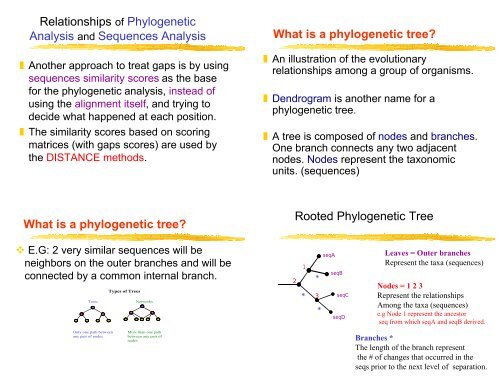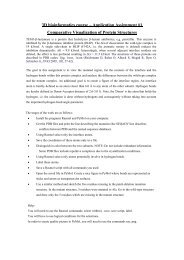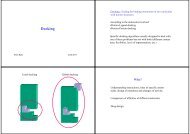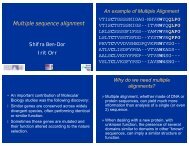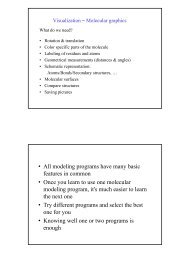Introduction to Phylogenetic Analysis
Introduction to Phylogenetic Analysis
Introduction to Phylogenetic Analysis
You also want an ePaper? Increase the reach of your titles
YUMPU automatically turns print PDFs into web optimized ePapers that Google loves.
Relationships of <strong>Phylogenetic</strong><br />
<strong>Analysis</strong> and Sequences <strong>Analysis</strong><br />
Another approach <strong>to</strong> treat gaps is by using<br />
sequences similarity scores as the base<br />
for the phylogenetic analysis, instead of<br />
using the alignment itself, and trying <strong>to</strong><br />
decide what happened at each position.<br />
The similarity scores based on scoring<br />
matrices (with gaps scores) are used by<br />
the DISTANCE methods.<br />
What is a phylogenetic tree?<br />
E.G: 2 very similar sequences will be<br />
neighbors on the outer branches and will be<br />
connected by a common internal branch.<br />
Trees<br />
Only one path between<br />
any pair of nodes<br />
Types of Trees<br />
Networks<br />
More than one path<br />
between any pair of<br />
nodes<br />
What is a phylogenetic tree?<br />
An illustration of the evolutionary<br />
relationships among a group of organisms.<br />
Dendrogram is another name for a<br />
phylogenetic tree.<br />
A tree is composed of nodes and branches.<br />
One branch connects any two adjacent<br />
nodes. Nodes represent the taxonomic<br />
units. (sequences)<br />
Rooted <strong>Phylogenetic</strong> Tree<br />
2<br />
1<br />
*<br />
*<br />
3<br />
*<br />
seqA<br />
seqB<br />
seqC<br />
seqD<br />
Leaves = Outer branches<br />
Represent the taxa (sequences)<br />
Nodes = 1 2 3<br />
Represent the relationships<br />
Among the taxa (sequences)<br />
e.g Node 1 represent the ances<strong>to</strong>r<br />
seq from which seqA and seqB derived.<br />
Branches *<br />
The length of the branch represent<br />
the # of changes that occurred in the<br />
seqs prior <strong>to</strong> the next level of separation.


